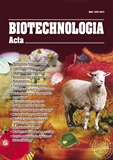ISSN 2410-7751 (Print)
ISSN 2410-776X (Online)

Biotechnologia Acta Т. 16, No. 2 , 2023
P. 15-17, Bibliography 4, Engl.
UDC: 577.218+577.214.6+615.322+59.084
DOI: https://doi.org/10.15407/biotech16.02.015
Full text: (PDF, in English)
RHODIOLA ROSEA AND FERULIC ACID ACTIVATE EXPRESSION OF GENES RELATED TO AUTOPHAGY AND RESISTANCE TO HEAT SHOCK IN MICE OF DIFFERENT AGE
O.I. DEMIANCHUK, M.V. IVANOCHKO, D.V. GOSPODARYOV, M.M. BAYLIAK
Department of Biochemistry and Biotechnology of Vasyl Stefanyk Precarpathian National University, Ivano-Frankivsk
The aim of our study was testing whether R. rosea extract and ferulic acid activate expression of targets of FoxO, regulators of energy metabolism and autophagy in livers of young and old mice, and to what extent the effects of R. rosea extract and ferulic acid on the genes studied coincide.
Methods. . C57BL/6J mice were reared at 22 ± 2 °С, 50-60% humidity, and 12/12 hour light/dark cycle. All groups were reared on a standard chow (4,8% fats, 21,8% protein, and 3,9% fibre). Experimental groups consumed water, supplemented with either sodium ferulate or R. rosea during 12 weeks prior sacrificing. The amounts of ferulate and R. rosea were adjusted to provide 4 mg of phenol-containing substances per 100 g weight, for a mouse, for 24 hours. We tested three-month-old (“young”) and twelve-month-old males (“old”).
The levels of messenger ribonucleic acid (mRNA) were assessed using AriaMx real-time polymerase chain reaction (RT-PCR) instrument (Agilent). Ribonucleic acid was purified using the Monarch Miniprep kit (New England BioLabs (NEB), T2010), complementary deoxyribonucleic acid synthesis was performed using the ProtoScript II kit (NEB, E6560), and quantitative RT-PCR (qRT-PCR) was performed using the Luna Universal kit (NEB, E3003). The expression of genes ATG5 (an autophagy marker), HSPB8 (a small heat shock protein, an FoxO target), UCP2 (uncoupling protein 2, a senescence marker), CDKN2 (cell cycle regulator, a senescence marker), PDK2 and PDK4 (pyruvate dehydrogenase kinases 2 and 4, regulators of oxidative metabolism), and TFEB (transcription factor EB, a transcriptional regulator of autophagy) was evaluated.
Results. Livers of young mice that consumed food supplemented with either sodium ferulate or R. rosea extract had 3.2-fold and 3.6-fold higher levels of mRNA of the small heat shock protein HspB8 than control mice, respectively.
In old mice, the levels of mRNA for this protein were 3.3-fold higher in mice reared on the diet containing R. rosea extract as compared with the control. However, there was no significant difference between control mice and those that consumed ferulate-supplemented food. In young mice, ferulate and R. rosea extract induced synthesis of mRNA of PDK4 by 4.3 and 6.6 times from the control level, respectively. Ferulate and R. rosea extract also affected the levels of mRNA of ATG5 and PDK2 in the livers of old mice.
The levels of PDK2 were 1.5-fold higher in the livers of mice that consumed ferulate-supplemented food than in control mice.
Conclusions. Both, R. rosea extract and one of its active components – ferulic acid – promote increasing in the levels of mRNA for genes HSPB8 and PDK4, coding for small heat shock protein and pyruvate dehydrogenase kinase 4, respectively. In old mice, R. rosea promote expression of HSPB8, ATG5, PDK2, and PDK4. Thus, ferulic acid and R. rosea exert similar effects on gene expression by supposed activation of heat shock response and autophagy, and concomitant inhibition of mitochondrial metabolism via boosting expression of PDK2 and PDK4.
Key words. Rhodiola rosea, ferulic acid, mice, PDK4, autophagy, mRNA.
© Palladin Institute of Biochemistry of the National Academy of Sciences of Ukraine, 2023
References
...1. Li H., Yu X., Meng F., Zhao Z., Guan S., Wang L. Ferulic acid supplementation increases lifespan and stress resistance via insulin/IGF-1 signaling pathway in C. elegans. Int. J. Mol. Sci. 2021, 22 (8), 4279. https://doi.org/10.3390/ijms22084279
2. Jiang S., Deng N., Zheng B., Li T., Liu R. H. Rhodiola extract promotes longevity and stress resistance of Caenorhabditis elegans via DAF-16 and SKN-1. Food. Funct. 2021, 12 (10), 4471–4483. https://doi.org/10.1039/d0fo02974b
3. Wiegant F. A., Surinova S., Ytsma E., Langelaar-Makkinje M., Wikman G., Post J. A. Plant adaptogens increase lifespan and stress resistance in C. elegans. Biogerontology. 2009, 10 (1), 27–42. https://doi.org/10.1007/s10522-008-9151-9
4. Liu J. K. Antiaging agents: safe interventions to slow aging and healthy life span extension. Nat. Prod. Bioprospect. 2022, 12 (1), 18. https://doi.org/10.1007/s13659-022-00339-y

